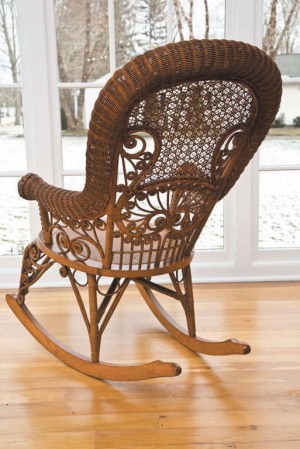Each year on April 1, I begin my evening walks. Living in an old historic neighborhood makes this a two-fold treat. First, I get some fresh air and a break from the pressures of the day, and secondly I get to view some wonderful turn-of-the-century homes.
My neighborhood is graced by winding streets, old trees and every type of front porch and landscape imaginable. Massive urns overflow with beautiful flowers. Corbels, gingerbread, and an array of architectural pieces are used for accents and unique fountains and statuary abound. Seeing each of these homes, you cannot help but be impressed by the individuality they express. There is, however, one constant that I have observed. More often that not, on the front porch, you will find at least one piece of wicker.
“Wicker” has become a generic word used to describe a number of materials found in nature and in some cases even twisted paper. By proper definition, wicker is “a product made of woven vines or stems.”
For over 150 years, fine American wicker has been produced using rattan vines imported from East Asia or Central America. These vines are filled with lengthwise fibers, giving them the strength of a multi-strand cable. It is this durability, and the large amount of wicker furniture produced during the American Victorian period, that has provided today’s collector with a wide selection of antique wicker.
When shopping for wicker, it may be best to avoid pieces with missing strands, excessive sagging or structural issues. Proper repair can be costly and should be done by a professional. Purchase if you must, but remember to calculate your repair costs before you buy. That $30 rocker could well end up costing $330!
Minor repairs can be done at home and they should start with a thorough cleaning. Surface dust can easily be removed with the brush attachment on your vacuum. For those stubborn deposits in the crevasses on the wicker, use a clean paint brush and for “fuzz” remove each piece with a pair of tweezers.
Murphy’s Oil Soap and warm water applied with a soft brush will loosen most dirt, which can then be washed away with a garden hose. Set the wicker in the shade for 2-3 hours on a day with a gentle breeze to dry and refrain from using it for 2-3 days.
The most common malady found on settees, chairs, and tables is loose strands at the base of the legs. Wrap the loose strand around the legs and secure them with wood glue and clamps and then set them aside for several days to allow them to cure and dry.
If you feel the piece needs a new coat of paint, use a solvent-based paint and apply as small an amount as possible. Over -painting is a common error many people make. This causes clumps of paint to form between the strands which will not only look bad, but will cause the strands to sag. For the best results, spraying is preferable to brushing.
The best way to maintain your wicker is by keeping it in a climate-controlled setting. Sun dries the strands and moisture can cause warping, so indoors is always your best bet. If you can’t resist using it outdoors, make sure it is on a covered porch or patio and bring it in or protect it with a tarp when there is the threat of rain.
To get that “wicker look” for the outdoors, without risking the integrity of your antique wicker, check out some of the new outdoor plastic or fiberglass wicker now being offered online and at most garden and patio shops. Until next time…Linda
Linda Kennett is a professional liquidation consultant specializing in down-sizing for seniors and the liquidation of estates and may be reached at 317-258-7835 or lkennett@indy.rr.com



